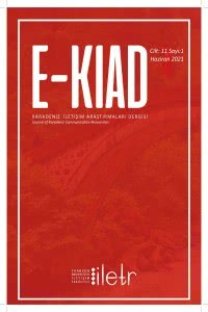YEREL FUTBOL TAKIMI MARKA ÇAĞRIŞIMLARININ KEŞFEDİLMESİ
Son dönemlerde futbol takımlarının markalanması ve marka yönetimleri önemli hale
gelmeye başlamıştır. Spor endüstrisi içinde marka değeri milyon dolarları bulan futbol
takımları vardır. Marka imajı tüketici zihnindeki çağrışım setleri olarak tanımlanabilir. Marka
imajı anlamak için, bu çağrışım setlerinin neler olduğunun tanımlanması gereklidir. Bu
çalışma Eskişehirspor futbol takımının marka çağrışımlarının tanımlanmasına yöneliktir.
Veri, zihin haritası yöntemi kullanılarak 159 katılımcıdan toplanmış ve sosyal ağ analizi
tekniği ile analiz edilmiştir. Analiz sürecinin ilk aşamasında her bir zihin haritası anketine içerik analizi uygulanmıştır. Analiz birimi olarak her bir ankette doldurulan çağrışımlar kabul
edilmiştir. İçerik analizi sonucunda tanımlanan çağrışımlar sosyal ağ analizinde düğümler,
çağrışımlar arasındaki ilişkiler de ayırt olarak kabul edilmiştir. Eskişehirspor için 15 marka
çağrışımı tanımlanmıştır. Analiz sonuçlarına göre taraftar kimliği, kulüp, logo ve renkleri,
kültür ve değerler en merkezde yer alan çağrışımlardır. Bu çalışmada elde edilen marka
çağrışım kategorileri Keller‟in çağrışım kategorileri ile uyum göstermektedir. Bu çalışma
ayrıca futbol takımları üzerinden Türk Futbol endüstrisi hakkında bir değerlendirme yapmak
isteyenlere bir fırsat sunmaktadır
Anahtar Kelimeler:
Marka imajı, marka çağrışımları, sosyal ağ analizi, spor
EXPLORING BRAND ASSOCIATIONS IN LOCAL SOCCER TEAM
Branding soccer teams and soccer team brand management are becoming important in recent days.
There are many soccer clubs with million-dollar brand values in the sports industry. Brand image can be defined
as association sets in the minds of consumers. In order to understand brand image, it is therefore necessary to
identify such association sets. This study set out to identify brand association sets for a local soccer team called
Eskişehirspor. Data was collected from 159 participants by utilizing a mind mapping survey and analyzing with
a social network analysis technique. In the first stage of analysis, each mind mapping survey was content
analyzed. The unit of analysis in the survey was each association filled in by the respondents. Associations
explored in the content analysis were accepted as nodes and connections between association were accepted as
ties for the network analysis. Fifteen brand associations were identified for Eskişehirspor. According to the
results, fan identification, club logo and colors, culture and values are the central brand associations. Findings
show that the prominence of attributed types of brand associations match Keller‟s categorization of types in this
context. This study presents an opportunity for others to evaluate the soccer teams in order to make an
assessment of Turkish football industry
Keywords:
Brand image, brand associations, social network analysis, sport,
___
- Aaker, D.A. (1991). Managing Brand Equity: Capitalizing On The Value Of A Brand Name. New York: Free Press
- Bauer, H. H., Sauer, N. E., & Exler, S. (2005). The loyalty of German soccer fans: does a team's brand image matter? International Journal of Sports Marketing and Sponsorship, 7 (1), 8-16.
- Bauer, H. H., Stokburger-Sauer, N. E., & Exler, S. (2008). Brand image and fan loyalty in professional team sport: A refined model and empirical assessment. Journal of sport Management, 22 (2), 205-226.
- Bauer, H. H., Sauer, N. E., & Schmitt, P. (2005). Customer-based brand equity in the team sport industry: Operationalization and impact on the economic success of sport teams. European Journal of Marketing, 39 (5/6), 496-513.
- Gladden, J. M. & Funk, D. C. (2001). Understanding brand loyalty in professional sport: Examining the link between brand associations and brand loyalty. International Journal of Sports Marketing and Sponsorship, 3 (1), 54-81.
- Gladden, J. M. & Funk, D. C. (2002). Developing an understanding of brand associations in team sport: Empirical evidence from consumers of professional sport. Journal of Sport management, 16 (1), 54-81.
- Gladden, J. M., Milne, G. R., & Sutton, W. A. (1998). A conceptual framework for assessing brand equity in Division I college athletics. Journal of sport management, 12 (1), 1- 19.
- Guo, L. (2012). The application of social network analysis in agenda setting research: A methodological exploration. Journal of Broadcasting & Electronic Media, 56 (4), 616-631.
- Henderson, G. R., Iacobucci, D. & Calder, B. J. (1998). Brand diagnostics: Mapping branding effects using consumer associative networks. European Journal of Operational Research, 111 (2), 306-327.
- Kadry, S. (2014). Social Network Analysis. Bentham e-books. eISBN: 978-1-60805-818-1
- Keller, K. L. (2008). Strategic Brand Management: Building, Measuring and Managing Brand Equity. New Jersey: Printice Hall.
- Keller, K.L. (1993). Conceptualizing, measuring, and managing customer-based based brand equity. Journal of Marketing, 57, 1-22.
- Wang, M. C. H. & Tang, Y. Y. (2017). Examining the antecedents of sport team brand equity: A dual-identification perspective. Sport Management Review, 21 (3), 293-306.
- Wasserman, S. & Faust, K. (1994). Social Network Analysis: Methods and Applications (Vol. 8). Cambridge university press.
- ISSN: 2146-3212
- Başlangıç: 2011
- Yayıncı: Karadeniz Teknik Üniversitesi
Sayıdaki Diğer Makaleler
TÜRK VE AMERİKAN POPÜLER SİNEMASINDA SUÇUN ESTETİĞİ
SEÇMENLERİN, OLUMLU/OLUMSUZ SİYASAL REKLAMLARIN KAYNAĞINA YÖNELİK TUTUMLARI
YEREL FUTBOL TAKIMI MARKA ÇAĞRIŞIMLARININ KEŞFEDİLMESİ
TÜRKİYE’DE ÜNİVERSİTE ÖĞRENCİLERİ ARASINDA SİBER GÜVENLİK ALGISI
